"A colour is a physical object as soon as we consider its dependence, for instance, upon its luminous source, upon other colours, upon temperatures, upon spaces, and so forth." -Ernst Mach
Our Sun, like all Sun-like stars, will come to the end of its life someday. All the hydrogen fuel in its core will eventually burn up, and when this happens, the core itself will begin to contract. When temperatures are finally high enough, the end product of hydrogen fusion -- Helium-4 -- will begin to fuse in the contracted core, and the Sun will expand into a Red Giant.
The outer layers of (mostly) hydrogen will become very diffuse, and will eventually be blown off as the Sun goes through the next phases of its life, culminating in a planetary nebula.
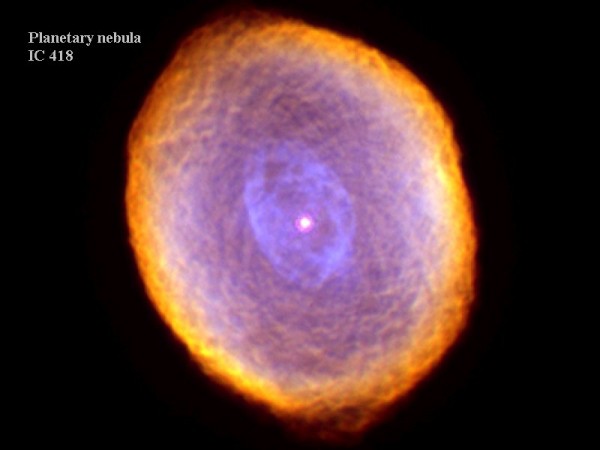
Image credit: NASA and The Hubble Heritage Team (STScI/AURA); Acknowledgment: Dr. Raghvendra Sahai (JPL) and Dr. Arsen R. Hajian (USNO).
The core of the (former) star will eventually contract down to a degenerate white dwarf, while the planetary nebula will expand to be multiple light years in size, eventually cooling and dimming away over the timespan of many tens of thousands of years.
This is the fate of all Sun-like stars in the Universe, as far as we know, and the planetary nebulae that result are varied and beautiful, as many of them have been captured in rich, fascinating detail by the Hubble Space Telescope.
These images are all taken in different visible light filters, with different colors highlighting different elements in each image. But in addition to the type of light we're used to, theoretical work told us that it might be possible to create photons of much more energetic wavelengths -- X-rays -- than are normally possible in stars, during this phase of a star's life.
In theory, how is this possible?
The gas surrounding the white dwarf can become so rarefied that the central, contracting star can super-heat the gas, shocking it, and causing the emission of diffuse X-rays near the central star. The surface of the star, as well, can become an X-ray emitting source, meaning that we can look for both a diffuse X-ray signal near the central region and a strong, X-ray point source at the location of the dying star itself.
And that's exactly what the Chandra X-ray Telescope did.
According to this recent paper, many of the nearest planetary nebulae to us were determined to exhibit exactly this. For the first time, point-source X-rays and diffuse X-rays could be separated out from one another.
In fact, the four planetary nebulae images by Hubble, three images up? They were found to all have diffuse X-ray emissions, and three of them were found to have central point sources, too! See for yourself what the X-ray data looks like.
This is incredibly impressive! In fact, data was taken for 34 different planetary nebulae, to see which ones had this diffuse X-ray emission and which ones didn't.
The results are incredibly educational.
While many of these nebulae of all types had point sources (and many didn't), it's the smallest planetary nebulae, and preferentially the lowest temperature ones as well, that have diffuse X-rays! It's thought that the point sources may have something to do with whether these planetary nebulae originated from binary star systems or not, but what about the diffuse X-rays? They may be because they're the youngest planetary nebulae, still expanding and -- in many cases -- becoming less dense and moving farther away from the central, contracting stellar remnant.
But for these dying stars that have had the privilege of being imaged by both Hubble and Chandra, it means we now have the most enticing, educational and spectrally diverse images ever taken of a planetary nebula. And we have it for a whopping four of them!
Don't laugh, that's four amazing pictures. You'll shut your mouth as soon as you click on each of the four individual images, below. There's the Cat's Eye Nebula, NGC 6543:
The latter three don't have colloquial names, so I'm going to give them some. There's NGC 7662, the Fedora Nebula:
There's NGC 7009, the Cheeseburger Nebula:
And finally there's NGC 6826, the Brain Damage Nebula!
Enjoy these new composite images, courtesy of Joel Kastner's international team and the Chandra X-ray Telescope, and keep in mind that this may give us a glimpse into our distant future: no discrete point source and a brief, diffuse X-ray glow in the early stages of our Sun becoming a planetary nebula!
(Thanks also to Peter Edmonds for bringing this story to my attention.)


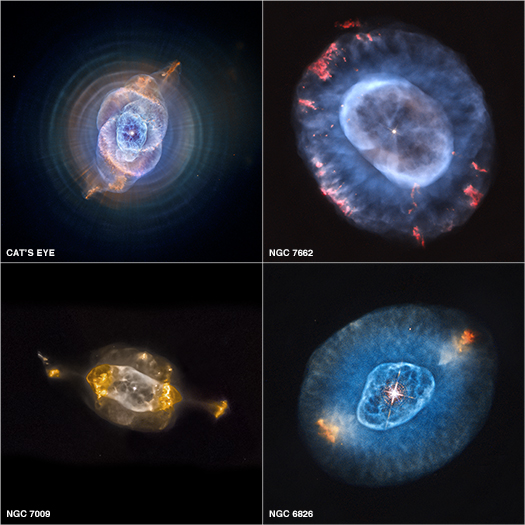
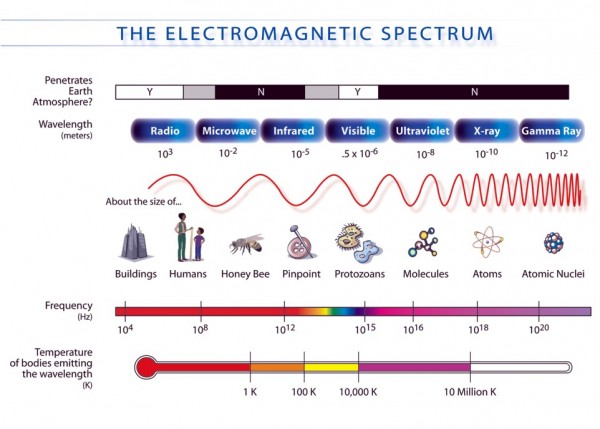
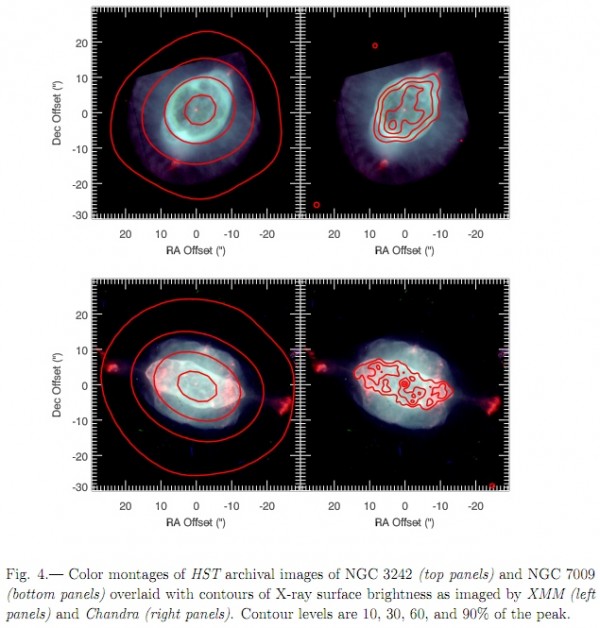

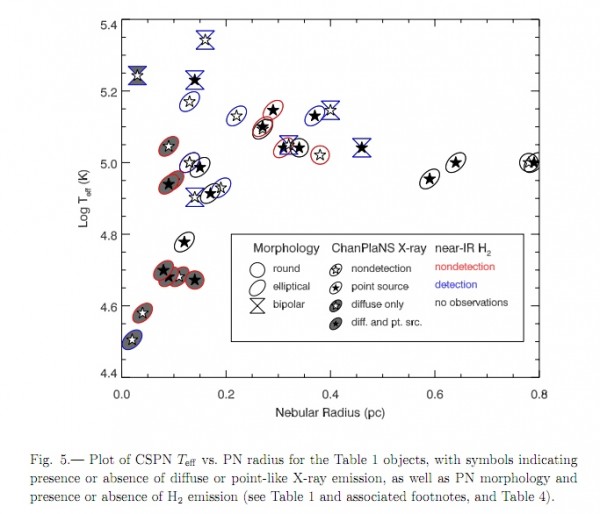
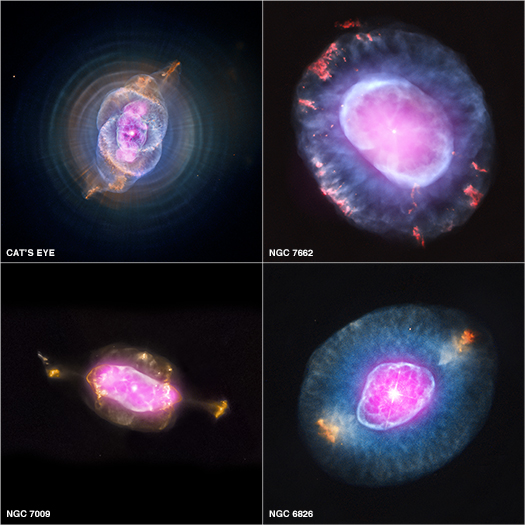
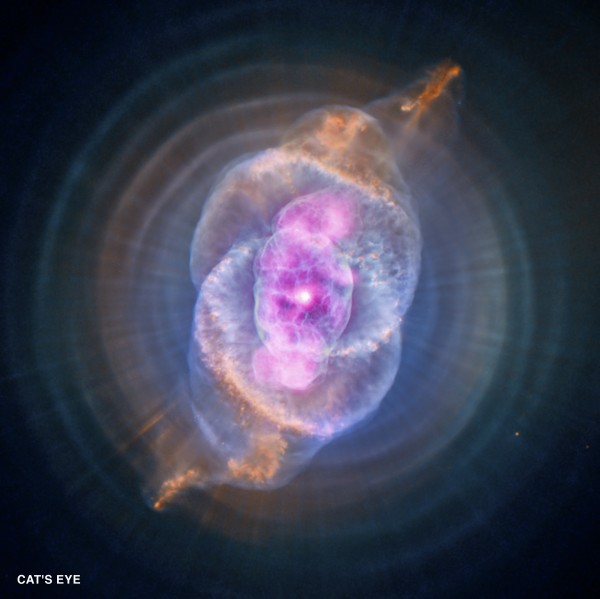
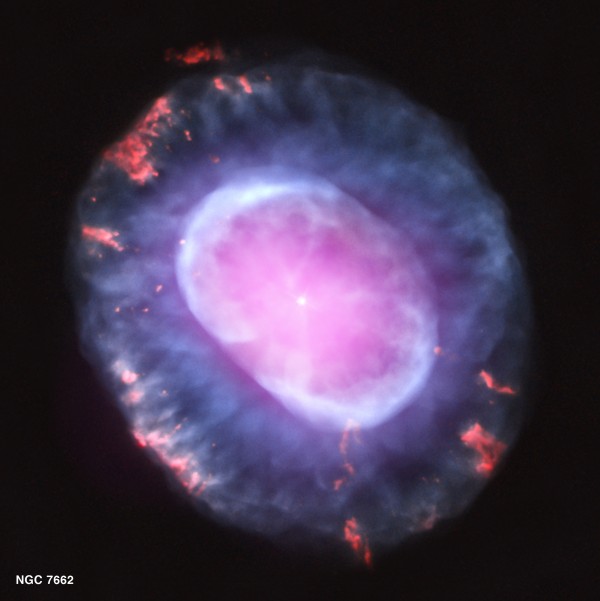

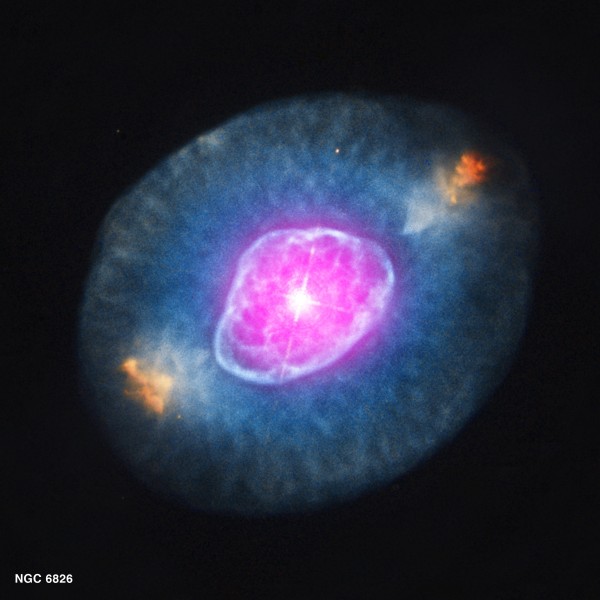
I just got a bit confused with the following statement
"The gas surrounding the white dwarf can become so rarefied that the central, contracting star can super-heat the gas, shocking it, and causing the emission of diffuse X-rays near the central star. The surface of the star, as well, can become an X-ray emitting source, meaning that we can look for both a diffuse X-ray signal near the central region and a strong, X-ray point source at the location of the dying star itself."
When you mention the 'Surface of the Star' can emit X-rays so you mean it emits X-Rays when its a red giant?
VDGG, a rarified gas can only lose heat through radiation in the allowed transition bands and this is very slow compared to the black body radiation allowed by a hot dense gas.
Therefore the heat can build up because the contracting star is stull giving a LOT of energy out to the gas enveloping it but that gas can't get rid of it.
And red giants don't emit hot enough to manage to give out X rays. Wolf-rayet hot blue giants and stellar cores (the bit that you see as a white dwarf) are much much hotter (40,00K for a Wolf Rayet, 100,000K or more for a white dwarf), there is quite a lot of X-Ray radiation possible compared to the ~3,000K for a red giant.
Apropos of nothing:
http://www.guardian.co.uk/science/gallery/2012/oct/12/space-science-sta…
That quote from Ernst Mach didn't really add anything.
First of all it reeks of Ernst Mach's idealism – an color is certainly not an object.
And secondly if anything, a color has two components: The physical reality and subjective perception.
- The physical properties of the objects and processes involved in creating the spectral composition of the emitted/reflected/absorbed/etc. light, and the physical properties of whatever is used to detect the light, is the first component – this is the objective, physical, "materialistic", reality, if you so want.
- And the subjective human perception of light (through physical, "materialistic", yet subjective processes in human eye and nervous system, that have evolved to reach their present form) is the second component.
As much as I think that Ernst Mach contributed to science, as much I think that his idealism was one of the things that held him back.
What's funny in this context was his "believe only your senses" policy (to draw a cartoon version of it), which had an anti-idealistic core to it, yet led him to reject several scientific theories of the time, not the least Einstein's work – with Einstein in turn crediting Ernst Mach as a base for his work.
There might be other quotes by Ernst Mach useful today, but this is not it.
With a quick search I couldn't find much useful quotes. His quote "Science itself, therefore, may be regarded as a minimal problem, consisting of the completest possible presentment of facts with the least possible expenditure of thought." seems to be a (poor) paraphrase of Occam's razor. His quote "Personally, people know themselves very poorly." is nice, but a banal truism.
And "In reality, the law always contains less than the fact itself, because it does not reproduce the fact as a whole but only in that aspect of it which is important for us, the rest being intentionally or from necessity omitted." Yeah. Science produces with "laws" an abstraction and approximation of the "facts" of reality.
Ernst Mach, not a good source for one-liners.
And oh, lest I forget: Really great images!
I wish I could include more images into the "False Color" wikipedia article, but I fear I put to many in it already… But if you have better suited examples that the currently included Astronomy example (Messier 66), feel free to go to wikipedia and edit the False Color article, take out Messier 66 and put another one there!
Tony, despite all those words laid out, I have ABSOLUTELY NO IDEA what it was you wanted to impart there other than some unflattering comments on Ernst Mach.
On second thought, the Messier 66 image was created using four channels, so use an Astronomy image with four channels if you want to change something there!
NGC 6826, the Brain Damage Nebula! I love it. The Fedora Nebula is a perfect moniker. Cheeseburger is a bit of a stretch, but not really any more than the colloquial names of many other nebula and so I'm more than happy with it. Can we google-bomb these terms so they become the de-facto names? or are you not supposed to mention when you're trying to manipulate google?
Let's change the subject.
How will NuSTAR contribute to these observations?
I like "Jelly Bean Nebula" for the second one.
Very nice science. Excellent work.
And very nice explanation.
Let me let it sink in.
Then I need to reread it again from the beginning.
Thanks for the education.
And what a sense of humor these astronomers have:
- the Cat’s Eye Nebula
- the Fedora Nebula
- the Cheeseburger Nebula
- the Brain Damage Nebula
If you're up late at night doing looking at stars; you might as well have a crazy good time with a lot of crazy talk.